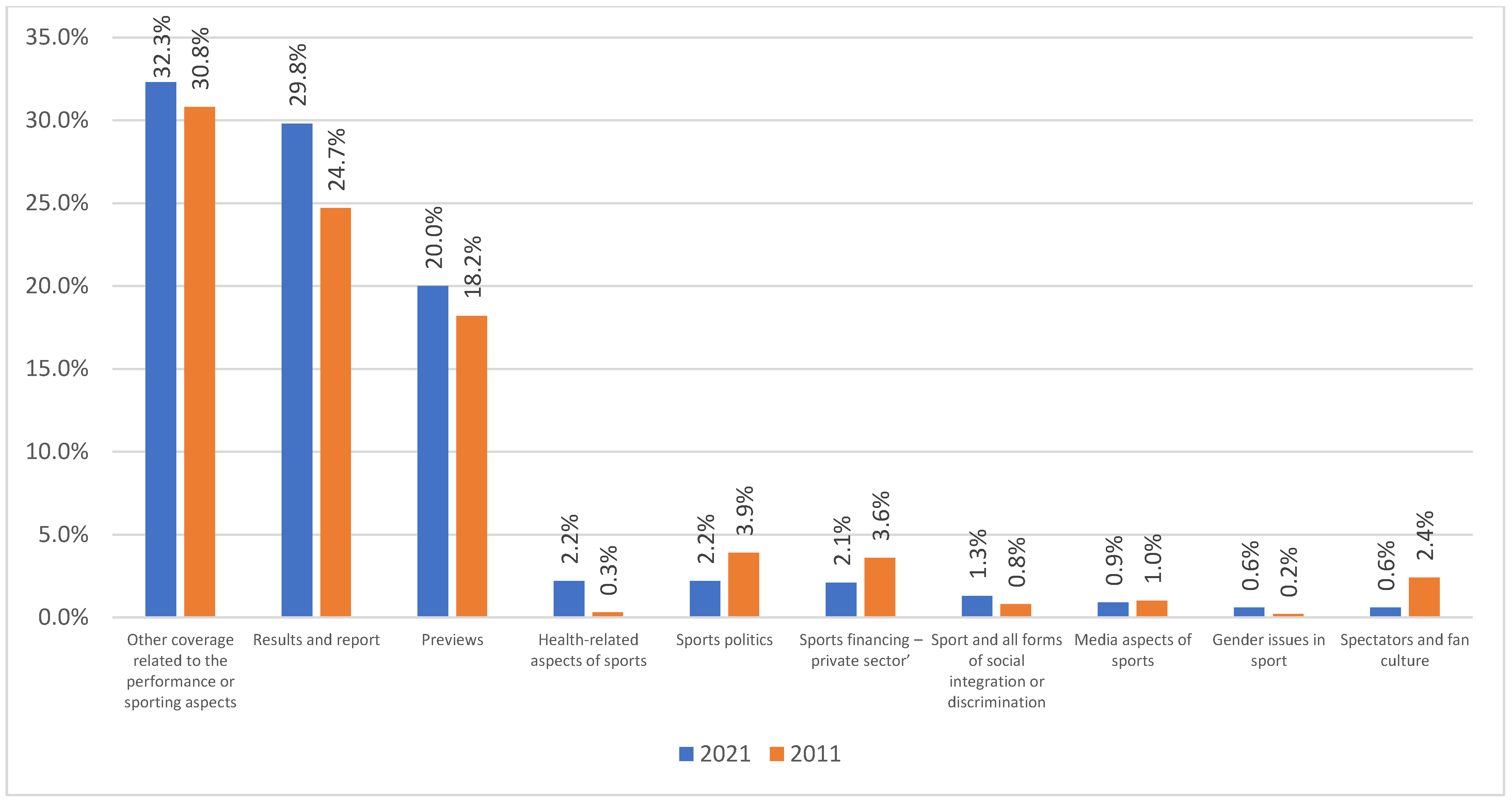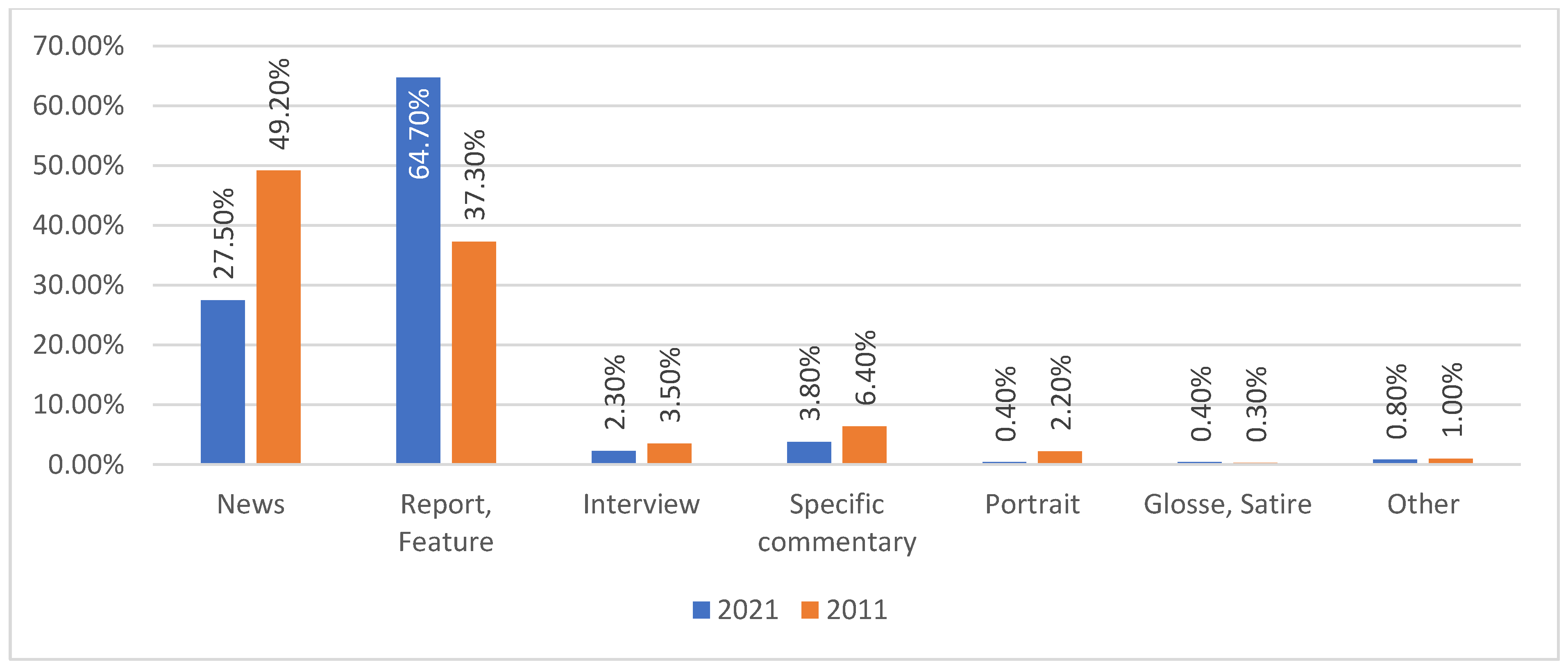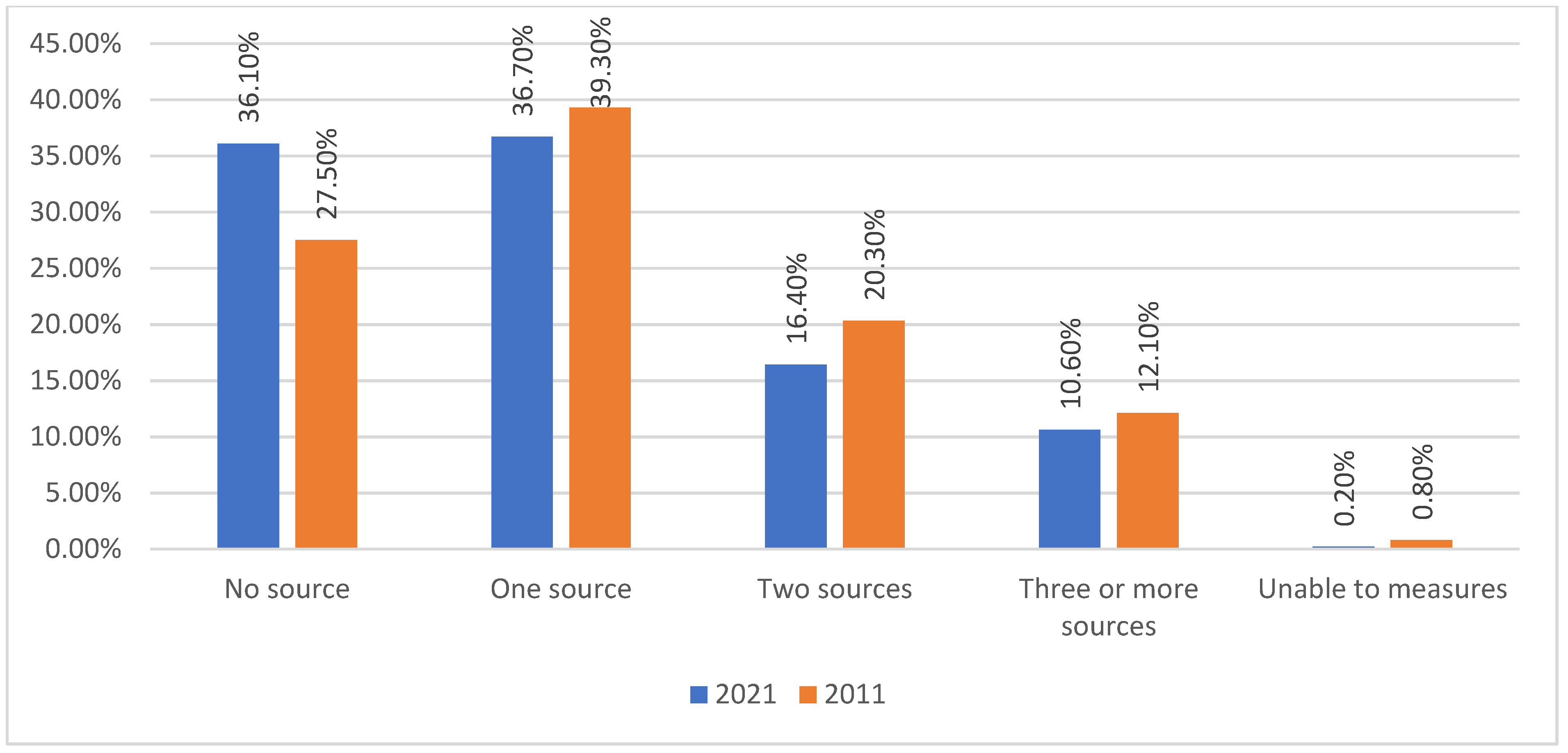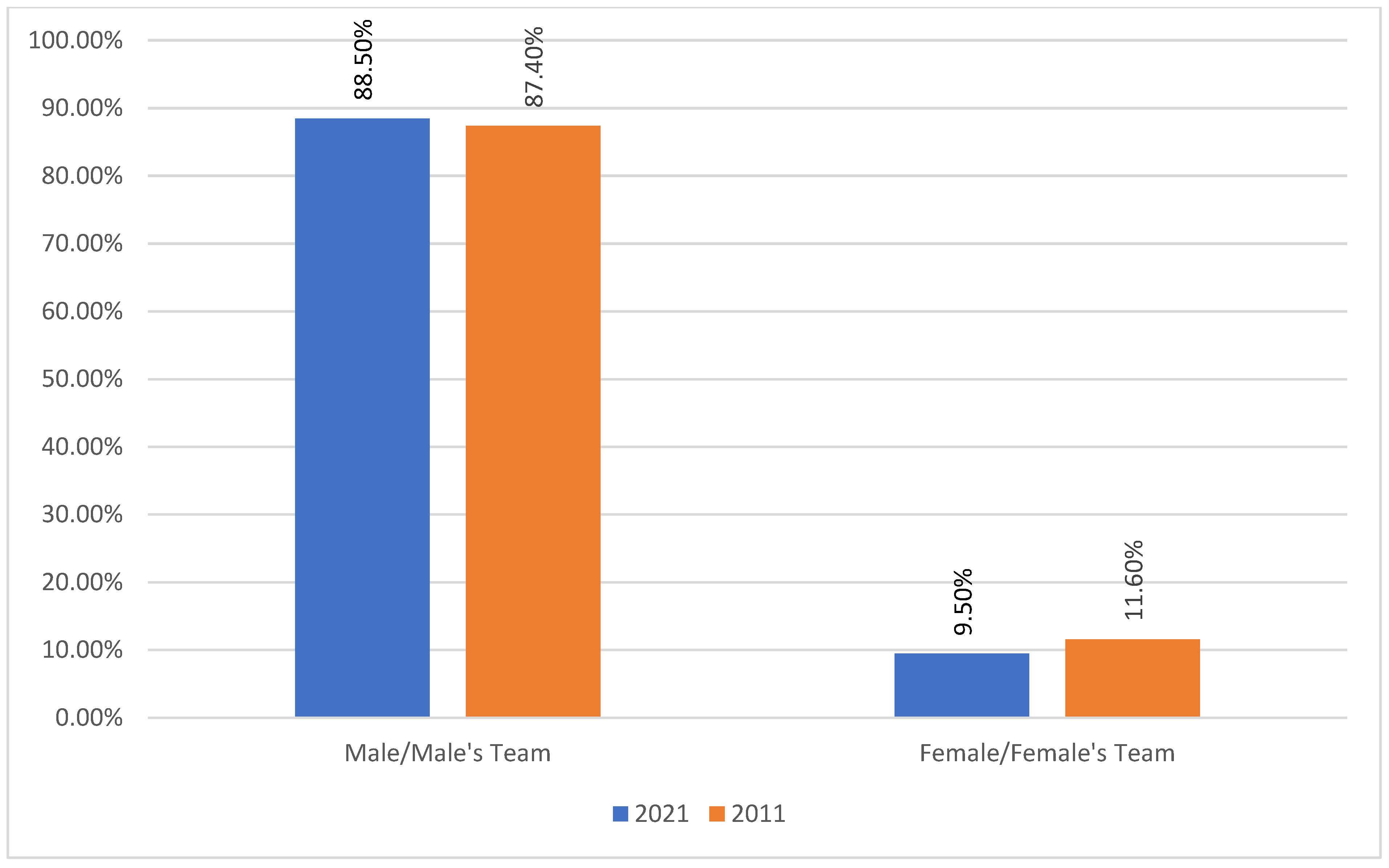The Toy Department Has Grown Up: The 2021 International Sports Press Survey (ISPS) in Comparison to the 2011 Survey
Abstract
1. Introduction
2. Literature Review: Changes and Challenges for Sports Journalism
“Sports journalism has different degrees of cultural and occupational status in different national and institutional contexts … Variations and patterns in the professional and public position of sports journalism occur across space, time, and publication type. It may be similarly assumed that there are parallels and divergences in the content, approach, and ideology of sports journalism across the globe, but such comparative data are rare and difficult to obtain.”
“Sports journalism […] cannot be quarantined from the requirements of critical investigation because of its popular cultural object. The debate concerning journalism and popular culture is of long standing, and has tended to revolve … around a binary distinction between seriousness and quality on one side, and superficiality and trivia (sometimes typified as ‘tabloid’) on the other”
2.1. Sports Coverage in Print Media
“We find that the representation of a plurality of active actors in a news article seems to go hand in hand with a more diverse range of viewpoints. The findings show that there are no significant differences in the level of actor and viewpoint diversity between quality and popular newspapers. However, the length of the article has a positive effect on providing more diversity”
2.2. International Sports Press Survey
3. Theoretical Approach
3.1. Quality
3.2. Diversity
3.3. Hypotheses
- Hypotheses block 1: formal diversity
- Hypotheses block 2: content diversity
4. Methodology
5. Results
5.1. Diversity of Content
5.2. Diversity of Formats Used and Number of Photos
5.3. Named Articles and Gender
5.4. Number of Sources
5.5. Gender of Athletes/Teams
5.6. Testing of Hypotheses
- H 1.1: sports reporting takes place in more and different formats and stylesThe shift from news coverage to reports is significant with X2 = (6; N = 13,058) = 1671.226; p < 0.01, Cramers V = 0.358, also the articles became bigger X2 = (3; N = 6273) = 249.610; p < 0.01, Cramers V = 0.199. H 1.1 would be supported.
- H 1.2: the number of images used increases (increase in visualization)Also, the number of used images increased significantly (X2 = (4; N = 13,066) = 51.418; p < 0.01, Cramers V = 0.063 with a small effect. (2021: M = 0.83; SD = 0.799; 2011: M = 0.75; SD = 0.796). H 1.2 would be supported. The variable was coded as quasi-metric.
- H 1.3: more sources are mentioned in sports reportingThis hypothesis is not easy to interpret, because even there is a significant difference between the two years X2 = (3; N = 12,993) = 115.144; p < 0.01, Cramers V = 0.094, the average of mentioned sources decreased slightly (2021: M = 1.01; SD = 0.974; 2011: M = 1.17; SD = 0.969). The variable was coded as quasi-metric.
- H 1.4: more named articles appearWith a X2 = (4; N = 13,058) = 333.679; p < 0.01, Cramers V = 0.160 we can also verify H 1.4.
- H 1.5: the number of female journalists increasesAs mentioned in the results, there are significantly less female authors in 2021. X2 = (1; N = 7824) = 11.509; p < 0.01, Cramers V = 0.38. H 1.5 cannot be supported.
- H 2.1: the number of topics and types of sport increases in sports reportingWith a significant result in the comparison between 2011 and 2021, but with a small effect, reported by X2 = (22; N = 13,062) = 490.723; p < 0.01, Cramers V = 0.194, H 2.1 would be supported, because more topics had been covered. Soccer/football is still the most covered sports discipline with 47.4% (2011: 44.6%) but depending on the countries a specific national sport is also in the focus of the sport journalistic coverage.
- H 2.2: more players and in particular female athletes are in the focus of sports reportingH 2.2 must be unsupported, because significantly less female athletes were in the focus of sport reporting X2 = (2; N = 8073) = 17.645; p < 0.01, Cramers V = 0.47.
- H 2.3: the number of critical topics reported on increasesH 2.3 cannot be proved easily. We can report that the topics, besides results and sports related content changed in the last ten years. “Doping” i.e., was 2021 in 1.8% part of the articles (2011: 4.4%). 2021 the coverage of “Health related aspects” were 12.3% (2011: 1.0%), and also “Sport and all forms of social integration or discrimination” increased from 2.9% in 2011 to 7.5% in 2021.
6. Discussion and Conclusions
7. Limitations
Author Contributions
Funding
Data Availability Statement
Conflicts of Interest
References
- Arnold, K. (2008). Qualität im Journalismus—Ein integratives konzept. Publizistik, 53(4), 488–508. [Google Scholar] [CrossRef]
- Beaudoin, C., Moreau, N., & Roy, M. (2024). ‘I can’t believe I just made history’: A temporal analysis of sports media reporting. International Review for the Sociology of Sport, 59(5), 766–786. [Google Scholar] [CrossRef]
- Beck, D., Schmid, L., & Suvajac, J. (2019). Nationale skistars in den Schweizer printmedien. MedienJournal, 43(1), 65–82. [Google Scholar]
- Billings, A. C., & Hardin, M. (Eds.). (2016). Routledge handbook of sport and new media. Routledge. [Google Scholar]
- Blackett, A. D. (2021). Malign and covert nationalism within British newspapers reporting of Eddie Jones’ appointment as head coach of the men’s England national rugby union team. International Review for the Sociology of Sport, 57(5), 715–733. [Google Scholar] [CrossRef]
- Boczek, K., Dogruel, L., & Schallhorn, C. (2023). Gender byline bias in sports reporting: Examining the visibility and audience perception of male and female journalists in sports coverage. Journalism, 24(7), 1462–1481. [Google Scholar] [CrossRef]
- Braumüller, B., Emberger, D., & Hartmann-Tews, I. (2020). Gendered coverage of the Olympic Games in German print media: A longitudinal content analysis in the context of participation, success and disciplines. European Journal for Sport and Society, 17(4), 319–338. [Google Scholar] [CrossRef]
- Burggraaff, C., & Trilling, D. (2020). Through a different gate: An automated content analysis of how online news and print news differ. Journalism, 21(1), 112–129. [Google Scholar] [CrossRef]
- Cassidy, W. P. (2017). Inching away from the toy department: Daily newspaper sports coverage of Jason Collins’ and Michael Sam’s coming out. Communication & Sport, 5(5), 534–553. [Google Scholar]
- Champion, K. (2015). Measuring content diversity in a multi-platform context. The Political Economy of Communication, 3(1), 39–56. [Google Scholar]
- Choi, Y. (2022). The Olympics, nationalism, and multiculturalism: News coverage of naturalized players in the Korean men’s national ice hockey team. International Review for the Sociology of Sport, 58(4), 666–684. [Google Scholar] [CrossRef]
- Coche, R., & Bell, T. R. (2024). Front-page prominence and newspaper ownership: Examining US women’s national team coverage after 2015 and 2019 World Cup victories. Journalism, 5(3), 710–728. [Google Scholar] [CrossRef]
- Cosell, H., & Bonventre, P. (1985). I never played the game. William Morrow & Co. [Google Scholar]
- Denham, B. E. (2019). Coverage of the Russian doping scandal in the New York Times: Intramedia and intermedia attribute agenda-setting effects. Communication & Sport, 7(3), 337–360. [Google Scholar]
- Eagleman, A. N. (2015). Constructing gender differences: Newspaper portrayals of male and female gymnasts at the 2012 Olympic Games. Sport in Society, 18(2), 234–247. [Google Scholar] [CrossRef]
- Falcous, M., & Scott, G. (2022). New Zealand’s princess of the pool: Post-ableism and the media narrativisation of Sophie Pascoe. International Review for the Sociology of Sport, 58(5), 889–907. [Google Scholar] [CrossRef]
- Finneman, T., & Thomas, R. J. (2022). “Our company is in survival mode”: Metajournalistic discourse on COVID-19′s impact on U.S. community newspapers. Journalism Practice, 16(10), 1965–1983. [Google Scholar] [CrossRef]
- Galily, Y., Cohen, N., & Levy, M. (2011). (Not) Higher, stronger or swifter: Representation of female olympic athletes in the Israeli Press. Journal of International Women’s Studies, 12(4), 57–78. [Google Scholar]
- Godoy-Pressland, A., & Griggs, G. (2014). The photographic representation of female athletes in the British print media during the London 2012 Olympic Games. Sport in Society, 17(6), 808–823. [Google Scholar] [CrossRef]
- Grix, J., Brannagan, P. M., Grimes, H., & Neville, R. (2021). The impact of COVID-19 on sport. International Journal of Sport Policy and Politics, 13(1), 1–12. [Google Scholar] [CrossRef]
- Hardin, M., Dodd, J. E., Chance, J., & Walsdorf, K. (2004). Sporting images in black and white: Race in newspaper coverage of the 2000 Olympic Games. Howard Journal of Communications, 15(4), 211–227. [Google Scholar] [CrossRef]
- Hardin, M., Zhong, B., & Whiteside, E. (2009). Sports coverage: “Toy department” or public-service journalism? The relationship between reporters’ ethics and attitudes toward the profession. International Journal of Sport Communication, 2(3), 319–339. [Google Scholar] [CrossRef]
- Hasebrink, U., Beaufort, M., & Oehmer-Pedrazzi, F. (2021). Qualität von nachrichtenmedien im dreiländervergleich. Zusammenhänge nutzungs- und angebotsbezogener kriterien. Media Perspektiven, 9, 450–460. [Google Scholar]
- Hendrickx, J., Ballon, P., & Ranaivoson, H. (2022). Dissecting news diversity: An integrated conceptual framework. Journalism, 23(8), 1751–1769. [Google Scholar] [CrossRef]
- Horky, T. (2010). Contents and patterns of construction of sports coverage in the press. Results from a cross-national comparative study. European Journal for Sport and Society, 7(3–4), 265–282. [Google Scholar] [CrossRef]
- Horky, T., & Nieland, J.-U. (2013). International sports press survey 2011. Quantity and Quality of Sports Reporting. BoD. [Google Scholar]
- Humprecht, E., & Esser, F. (2018). Diversity in online news. Journalism Studies, 19(12), 1825–1847. [Google Scholar] [CrossRef]
- Hutchins, B., & Rowe, D. (Eds.). (2016). Digital media sport. Technology, power and culture in the network society. Routledge. [Google Scholar]
- Ihle, H. (2023). How gender affects the newsworthiness of sports news on German TV: An application of the news-factors approach to understanding gender-biased sports news presentation. International Review for the Sociology of Sport, 58(2), 253–277. [Google Scholar] [CrossRef]
- Ismail, S., & Mohd Adnan, H. (2016). Profile of sports section and sports journalism practice in Malaysian national newspaper: Focus on Malay language print media. Sociology and Anthropology, 4(6), 500–507. [Google Scholar] [CrossRef]
- Jakubowska, H. (2013). The world of sports in newspapers based on the results of “the international sports press survey”. Studia Medioznawcze, 52(1), 1–20. [Google Scholar]
- Jakubowska, H., & Ličen, S. (2019). The role of newspapers in the formation of gendered national identity: Polish coverage of women’s and men’s basketball championships. International Review for the Sociology of Sport, 54(3), 302–324. [Google Scholar] [CrossRef]
- Jiang, Q. (2013). Celebrity Athletes, soft power and national identity: Hong Kong newspaper coverage of the Olympic Champions of Beijing 2008 and London 2012. Mass Communication and Society, 16(6), 888–909. [Google Scholar] [CrossRef]
- Joris, G., De Grove, F., Van Damme, K., & De Marez, L. (2020). News diversity reconsidered: A systematic literature review unraveling the diversity in conceptualizations. Journalism Studies, 21(13), 1893–1912. [Google Scholar] [CrossRef]
- Kian, E. M., & Clavio, G. (2011). A Comparison of online media and traditional newspaper coverage of the men’s and women’s U.S. open tennis tournaments. Journal of Sports Media, 6(1), 55–84. [Google Scholar] [CrossRef]
- Kian, E. M., Fink, J. S., & Hardin, M. (2011). Examining the impact of journalists’ gender in online and newspaper tennis articles. Women in Sport and Physical Activity Journal, 20(2), 3–21. [Google Scholar] [CrossRef]
- Krippendorf, K. (2018). Content analysis. An introduction to its methodology (4th ed.). Sage. [Google Scholar]
- Lauerer, C., Dingerkus, F., & Steindl, N. (2019). Journalismus zwischen unabhängigkeit und einfluss. In T. Hanitzsch, J. Seethaler, & V. Wyss (Eds.), Journalismus in Deutschland, Österreich und der Schweiz (pp. 71–102). Springer VS. [Google Scholar]
- Masini, A., & Van Aelst, P. (2017). Actor diversity and viewpoint diversity: Two of a kind? Communications, 42(2), 107–126. [Google Scholar] [CrossRef]
- Masuch, M., & Butryn, T. M. (2013). Writing about fighting. A critical content analysis of newspaper coverage of the ultimate fighting championship from 1993–2006. Journal of Sports Media, 8(1), 19–44. [Google Scholar] [CrossRef]
- Maurer, M., & Reinemann, C. (2006). Medieninhalte: Eine einführung. Springer VS. [Google Scholar]
- McEnnis, S. (2020). Toy department within the toy department? Online sports journalists and professional legitimacy. Journalism, 21(10), 1415–1431. [Google Scholar] [CrossRef]
- McQuail, D. (1992). Media performance. Mass communication and the public interest. Sage. [Google Scholar]
- Newman, N., Fletcher, R., Robertson, C. T., Eddy, K., & Nielsen, R. K. (2022). Reuters institute digital news report 2022. Available online: https://reutersinstitute.politics.ox.ac.uk/digital-news-report/2022 (accessed on 13 January 2025). [CrossRef]
- Perreault, G., & Bell, T. R. (2022). Towards a “digital” sports journalism: Field theory, changing boundaries and evolving technologies. Communication & Sport, 10(3), 398–416. [Google Scholar]
- Poole, G. A. (2009). Back to the future: How sports journalism can recapture its relevance. Columbia Journalism Review, 47, 19–21. [Google Scholar]
- Ramon, X. (2016). Challenging gender inequalities or reinforcing old stereotypes? The coverage of sportswomen in the British, American and Spanish quality press during the London 2012 Olympics from the lens of journalism ethics. Textual & Visual Media, 9, 73–94. [Google Scholar]
- Rowe, D. (2007). Sports journalism: Still the ‘toy department’ of the news media? Journalism, 8(4), 385–405. [Google Scholar] [CrossRef]
- Rowe, D. (2013). The state of the sports press: Reflections on an international study. In P. M. Pedersen (Ed.), Routledge handbook of sport communication (pp. 165–177). Routledge. [Google Scholar]
- Schaffrath, M. (2011). Fußball-Reporterinnen. Hohe akzeptanz bei niedrigen bekanntheitswerten. Fachjournalist, 4, 27–29. [Google Scholar]
- Schatz, H., & Schulz, W. (1992). Qualität von fernsehprogrammen. Kriterien und methoden zur beurteilung von programmqualität im dualen fernsehsystem. Media Perspektive, 11, 690–712. [Google Scholar]
- Schultz-Jørgensen, S. (2005). The world’s best advertising agency: The sports press. Mandag Morgen. Available online: https://www.playthegame.org/media/ozognyk5/sport_press_survey_english.pdf (accessed on 12 March 2023).
- Seeger, C., Horky, T., Nieland, J.-U., & English, P. (2023). Social media publishing strategies of German newspapers: Content analysis of sports reporting on social networks by German newspapers—Results of the 2021 social media international sports press survey. Journalism and Media, 4(2), 599–611. [Google Scholar] [CrossRef]
- Stark, B., Riedl, A., Eisenegger, M., Schneider, J., Udris, L., & Jandura, O. (2021). Qualität des politischen nachrichtenangebots in deutschland. Empirische kernbefunde aus dem ländervergleichenden projekt “Media Performance and Democracy”. Media Perspektiven, 9, 430–449. [Google Scholar]
- Strong, C., & Hannis, G. (2007). The visibility of female journalists at Australian and New Zealand newspapers: The good news and the bad news. Australian Journalism Review, 29(1), 115–126. [Google Scholar]
- Urban, J., & Schweiger, W. (2014). News quality from the recipients’ perspective. Journalism Studies, 15(6), 821–840. [Google Scholar] [CrossRef]
- Van Cuilenburg, J. (1999). On competition, access and diversity in media, old and new: Some remarks for communications policy in the information age. New Media & Society, 1(2), 183–207. [Google Scholar] [CrossRef]
- Vincent, J., Kian, E., & Pedersen, P. M. (2011). Flying the flag: Gender and national identity in English newspapers during the 2006 World Cup. Soccer & Society, 12(5), 613–632. [Google Scholar]
- Voakes, P. S., Kapfer, J., Kurpius, D., & Chern, D. S.-Y. (1996). Diversity in the news: A conceptual and methodological framework. Journalism & Mass Communication Quarterly, 73(3), 582–593. [Google Scholar] [CrossRef]
- Vogler, D. (2021). Sportberichterstattung in Schweizer nachrichtenmedien. Eine vergleichende analyse aus einer normativen qualitätsperspektive von 2011–2019. Journal für Sportkommunikation und Mediensport, 6(1–2), 11–26. [Google Scholar]
- Vögele, C., & Seeger, C. (2020). Von der ereigniszentrierten 1:0-berichterstattung zu mehr hintergrund und vielfalt?: Eine inhaltsanalyse der lokalsportteile in drei regionalzeitungen im grossraum Stuttgart in den jahren 1977, 1997 und 2017. Journal für Sportkommunikation und Mediensport, 5(1–2), 31–47. [Google Scholar]
- Wan-Ifra. (2022, May 4). World press trends outlook 2021–2022. Available online: https://wan-ifra.org/insight/world-press-trends-outlook-2021-2022/ (accessed on 13 January 2025).
- Weedon, G., Wilson, B., Yoon, L., & Lawson, S. (2018). Where’s all the ‘good’ sports journalism? Sports media research, the sociology of sport, and the question of quality sports reporting. International Review for the Sociology of Sport, 53(6), 639–667. [Google Scholar] [CrossRef]
- Weischenberg, S., Malik, M., & Scholl, A. (2006). Die souffleure der mediengesellschaft. Report über die Journalisten in Deutschland. UVK. [Google Scholar]
- Wenner, L. A., & Billings, A. C. (2017). Sport, media and mega-events. Routledge. [Google Scholar]
- Wöhrer, A., & Jungblut, M. (2022). Sportarten im aufstiegskampf? Eine analyse der vielfältigkeit und der struktur der sportjournalistischen berichterstattung der Tagesschau. Medien & Kommunikationswissenschaft, 70(4), 404–422. [Google Scholar] [CrossRef]






| Australia | Brazil | Germany | South Africa | USA | Greece | France | Total | |
|---|---|---|---|---|---|---|---|---|
| Quality Press | 207 | 114 | 730 | 133 | 409 | 141 | 23 | 1757 |
| Popular Press | 494 | 124 | 365 | 132 | 683 | 419 | 38 | 2255 |
| Regional Press | 420 | 233 | 1138 | 153 | 278 | 226 | 154 | 2602 |
| Total | 1121 | 471 | 2233 | 418 | 1370 | 786 | 215 | 6614 |
| Title of Newspaper | |
|---|---|
| Australia | The Australian, Herald Sun, West Australian |
| Brazil | O Globo, Meia Hora |
| Germany | Frankfurter Allgemeine Zeitung, BILD, Hamburger Abendblatt, Süddeutsche Zeitung, Westdeutsche Allgemeine, die tageszeitung |
| South Africa | Daily Sun |
| USA | Washington Post, USA Today, New York Post |
| Greece | Kathimerini, Ta Nea |
| France | Le Monde |
| Weighting Factor 2021 | Weighting Factor 2011 | |
|---|---|---|
| Australia | 0.842 | 0.552 |
| Brazil | 2.066 | 1.649 |
| Germany | 0.423 | 0.485 |
| South Africa | 2.260 | 1.769 |
| USA | 0.690 | 1.374 |
| Greece | 1.202 | 1.390 |
| France | 4.395 | 1.961 |
| Male/Male Teams | Female/Female Teams | |
|---|---|---|
| Australia | 87.8% | 12.2% |
| Brazil | 94.5% | 5.2% |
| Germany | 85.8% | 13.5% |
| South Africa | 90.5% | 9.5% |
| USA | 82.4% | 11.4% |
| Greece | 88.0% | 9.3% |
| France | 89.0% | 10.9% |
Disclaimer/Publisher’s Note: The statements, opinions and data contained in all publications are solely those of the individual author(s) and contributor(s) and not of MDPI and/or the editor(s). MDPI and/or the editor(s) disclaim responsibility for any injury to people or property resulting from any ideas, methods, instructions or products referred to in the content. |
© 2025 by the authors. Licensee MDPI, Basel, Switzerland. This article is an open access article distributed under the terms and conditions of the Creative Commons Attribution (CC BY) license (https://creativecommons.org/licenses/by/4.0/).
Share and Cite
Horky, T.; Nieland, J.-U.; Seeger, C. The Toy Department Has Grown Up: The 2021 International Sports Press Survey (ISPS) in Comparison to the 2011 Survey. Journal. Media 2025, 6, 81. https://doi.org/10.3390/journalmedia6020081
Horky T, Nieland J-U, Seeger C. The Toy Department Has Grown Up: The 2021 International Sports Press Survey (ISPS) in Comparison to the 2011 Survey. Journalism and Media. 2025; 6(2):81. https://doi.org/10.3390/journalmedia6020081
Chicago/Turabian StyleHorky, Thomas, Joerg-Uwe Nieland, and Christof Seeger. 2025. "The Toy Department Has Grown Up: The 2021 International Sports Press Survey (ISPS) in Comparison to the 2011 Survey" Journalism and Media 6, no. 2: 81. https://doi.org/10.3390/journalmedia6020081
APA StyleHorky, T., Nieland, J.-U., & Seeger, C. (2025). The Toy Department Has Grown Up: The 2021 International Sports Press Survey (ISPS) in Comparison to the 2011 Survey. Journalism and Media, 6(2), 81. https://doi.org/10.3390/journalmedia6020081







